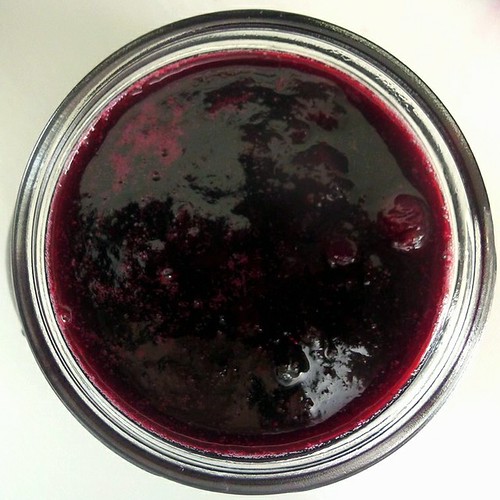Workshops, Recipes & Our Wild Blueberry Lemon Jam

Just as night follows day, a deluge of fresh fruits can sometimes lead to jam. Jam is one of summer food’s wonderful spin-offs. When the luxury of copious amounts of fruit surrounds us, jam is a way to utilize our beautiful excess. It provides us with a gift for friends and neighbors and a way to recall summer’s bounty when it’s darker and colder.
We’ve discussed jam’s advantages and its caveats in a previous post (Jam-tastic! from June 2011). While its deliciousness is undisputed, it’s true that some nutrients are lost when berries turn to jams. According to Livestrong.com, boiling that occurs in the process of canning changes fruits’ enzymes, reducing its vitamins by as much as one-half to one-third. Vitamins possess the antioxidant activity that fruits like wild blueberries, for example, are famous for.
Dr. Daniel Nadeau recently pointed out that fruits like blueberries are best eaten raw or frozen to take full advantage of their disease-preventing power. Still, jam has many advantages for the healthy eater. It has half the calories of butter, which it is often substituted for, and it is low in cholesterol. And, by boiling and canning fruits yourself, you avoid processed foods with added sugar and preservatives while passing along a respectable amount of nutrient content. Did we also mention it is famously palate-pleasing? It lends a fruit forward essence to toast, cheese, crackers, yogurt – even coffee.*
Buried in Berries? Start Here
Put your fresh fruit where your mouth is and get hands-on with summer’s crop of wild blueberries. Two hands-on workshops, sponsored by the University of Maine Cooperative Extension, provide a practical lesson on making low-sugar blueberry jam and low-sugar blueberry spice jam for those who live in southern Maine. Both workshops will be taught by master food preserver Kate McCarty and will be held at 75 Clearwater Drive in Falmouth at a cost of $10. The Blueberry Jam Workshop will be held 5:30 to 8:30 p.m. Aug. 2; the Blueberry Spice Workshop will be on Aug. 11. For more information or to register, call 781-6099 or e-mail lois.elwell@maine.edu.
Jam Tomorrow, Jam Today
When the White Queen told Alice that there would be jam yesterday and jam tomorrow but never jam today, it’s no wonder the poor girl was confused. We can relate: sometimes it seems the ever-unreachable treat will never come. It makes jam the perfect object lesson when it comes to the indulgences of summer – the promise of a little now and a little later is infinitely more digestible.
Make today’s summer tastes last until tomorrow by getting creative with your jams. Huff Post recommends a few jam recipes to inspire you. Their Mixed Berry Jam allows a mélange of summer’s berries for even bigger berry taste – the result is the “ultimate” jam. With Simplest Rhubarb Jam you won’t let one of the season’s most popular fruits go unjarred. This jam makes a luscious condiment for cheese, for example. Huff also recommends putting Fresh Fruit Butter into your repertoire. Fruit butter – for which wild blueberries are a perfect choice – doesn’t use pectin and is thick and sticky for when you’d rather smear than dollop.
Jam Don’t Shake Like That
Jam’s counterpart, jelly, is usually known for being made from an ingredient’s juice or essence rather than its crushed whole. Blueberry harvest season is a perfect opportunity to join two favored flavors in jelly form. Wild blueberries and hot peppers pop when paired – they work so well together that you’ll want this combo in everything from meats to appetizers. This Blueberry Pepper Jelly recipe is from Lauri Jon Bennett, who promises that you can jar your jams and jellies without buying lots of expensive canning equipment. (She improvises by using rubber bands wrapped around kitchen tongs to create a jar lifter.) She also offers up a recipe for “addictive” Blackberry Jam with Lemon Zest or her Peach Jam with Lemon Thyme and Almonds for some lip-smacking seasonal zing.
If even a moderate jarring operation isn’t for you, you can still enjoy jam with your bounty of blues. Use them in this easy Wild Blueberry Lemon Jam from the wildblueberries.com recipe bank that requires only jars and a boiling water canner. Waffles have never been this mouth-watering. It weighs in at 34 calories per tablespoon.

Prefer to make your own pectin? Using homemade pectin means you’re making completely natural preserves. Learn about making your own pectin for jams and jellies from pickyourown.org.
*Have a unique use for jams and jellies? Let us know by leaving a comment. We’ll use the best in our Best of Fresh Blues list!
Top photo: Blueberry Jam








